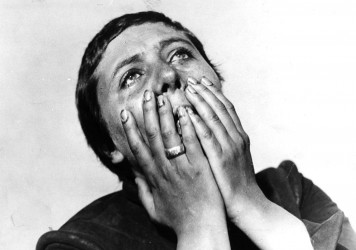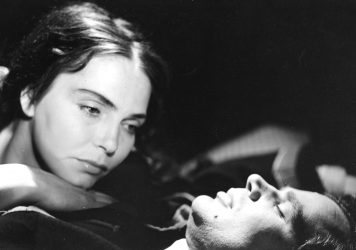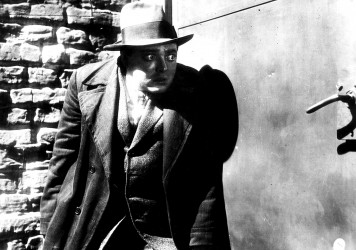
While on location making his debut feature, The Student of Prague, in 1913, actor/co-director Paul Wegener first heard stories about the Golem of Jewish folklore, and the creation of one of these servants of clay by the late-16th-century rabbi of Prague, Judah Loew ben Bazelei. His interest piqued, Wegener devoted his next feature, Der Golem, to the subject. This he co-wrote and co-directed with Henrik Galeen, who would later write FW Murnau’s Nosferatu and Paul Leni and Leo Birinski’s Waxworks. In other words, the raw materials of Der Golem would reconstitute themselves to form and inform much of the German silent era horror that followed.
Still, the original Der Golem is now lost – as is its comic follow-up The Golem and the Dancing Girl, which Wegener wrote and co-directed with Rochus Gliese, and which was an early example of both horror spoof and postmodern horror in that it starred Wegener as a horror actor (which he really was) who uses his Golem costume (which he really had) to help woo a woman. Unhappy with some of the production compromises that had beset his 1915 film, in 1920 Wegener joined forces with co-director Carl Boese and (again) with co-writer Galeen to remould the Jewish folktale into a part remake, part prequel.
Known in full as Der Golem, Wie er Kam in die Welt (The Golem: How He Came into the World), the film is confusingly often referred to as Der Golem for short, just like the original. Reconstructing medieval Prague with painted, angular, heavily stylised sets in a Berlin studio, this extant Der Golem would, along with Robert Wiene’s The Cabinet of Dr Caligari from the same year, introduce German Expressionism as the nightmarish, neurotic mode of horror cinema.
This later Der Golem comes brimming with a sense of foreboding, of apocalyptic doom, and of impending ‘terrible calamity’. “The stars reveal to the revered Rabbi Löw that the Jewish community is threatened by severe harm,” reads the opening intertitle, as we see Loew (Albert Steinrück) perched atop his tower with telescopic apparatus and astrological tomes. Sure enough, the foppish envoy Florian (Lothar Müthel) is about to visit the ghetto with an imperial edict for the expulsion of all Jews from the city before the New Moon.
The reasons behind the edict are a typical ‘blood libel’ – although it is ironic that among the charges listed against the local Jews is a claim that they are “able to use black magic”, since it is the existence of the edict itself which will drive Loew to turn to the ancient Kaballah and resort to such black magic to animate a Golem.
While the hulking, literally statuesque Golem (played again by Wegener), restored to life in part through an Astaroth-raising ritual, comes with great strength, Loew initially plans to use it only for household chores and as a prop in his petition to the Emperor (Otto Gebühr). When the imperial palace starts collapsing, the Golem’s intervention will save the lives of all those inside, earning the Jews a reprieve from the grateful Emperor.
Yet the Golem quickly switches from saviour of the Bohemians to bringer of conflagration to the Jews, as its demonic origins and destructive impulses lead it on a rampage of crushing and burning. The catalyst for this is a forbidden love affair between Loew’s daughter Miriam (Lyda Salmonova) and the Christian (i.e. goyish) Florian – the kind of ‘marrying out’ which has always been perceived as a threat to the integrity of the Jewish community.
While it seems obvious that the doom-laden anxieties of Der Golem look back to the First World War, it is also tempting to read, in this film full of seers, astrologists and prophets, early signs of a future in which (ever-present) antisemitism would flare up again, forcing Jews into exile or consuming them in flames. For Der Golem, from its Weimar-era vantage, looks ahead to something like the rise of the Third Reich – while also, more straightforwardly and less perniciously, anticipating many of the motifs that would be found in James Whale’s 1931 Frankenstein.
Der Golem anticipates cinema in another way too. Asked by the Emperor to perform another act of illusionism, Loew says, “Let me show you our Jewish forefathers, O mighty Emperor, so you better come to know our people.” In the phantasmagorical presentation that follows, the Rabbi magically projects moving images (depicting Exodus and the Wandering Jew) onto the palace’s inner walls, in what is not only a clear precursor to cinema itself, but also a mise en abyme of the very film that we are watching, which in its own way is also exposing European viewers to Jewish customs, lore and history. The ridiculing response of the Imperial audience literally brings the house down, and serves as a warning about the potential consequences of disrespecting other cultures.
In the end, the Golem smashes apart the gate that separates the Jewish ghetto from the rest of Prague. It is an ambiguous act: in part an escape attempt, in part a bid to spread previously contained havoc, in part a literal breaking down of ethnic and cultural barriers. The film too equivocates in its representation of European Jewry, casting Jews in a sympathetic light as beleaguered victims of arbitrary oppression, while simultaneously othering, even demonising, them as wizard-hatted occultists who dabble in necromancy and other Satanic practices.
These are two very distinctive perceptions of Judaism, one of which would come tragically to dominate in Europe over the ensuing decades. So it’s a complicated picture – much as the Golem itself embodies domestic drudgery, superheroic deeds and indiscriminate holocaust. As the stony creature with the pageboy cut, Wegener somehow conveys both indignant confusion and sinister menace – and the final scene in which he encounters a fearless little girl is all at once tender and terrifying (inspiring the most famous sequence in Whale’s Frankenstein).
Lovingly restored in its full tinted glory, The Golem is available with three separate musical accompaniments (four if you include the one with the shorter US version of the film, also included in Eureka!’s package). Though it may be anachronistic (for a film both set and made in eras that preceded the invention of electronic instruments), Wudec’s score works particularly well, both for the dark vibe of dread that it brings to the material, and for the implicit continuity that it forges between the antisemitism of yesteryear and of today.
The Golem: How He Came into the World is released by Eureka! Video, as part of its Masters of Cinema Series, on Blu-ray in a new 4K restoration of the original film negatives on 18 November.
Published 18 Nov 2019

By Lara C Cory
Portishead’s Adrian Utley and Goldfrapp’s Will Gregory discuss writing new music for The Passion of Joan of Arc.

By Anton Bitel
A newlywed woman is transformed into a vampiric beast in Erik Blomberg’s supernatural tale.

This tale of a wily German child murderer from legendary director Fritz Lang is still one of the all-time greats.